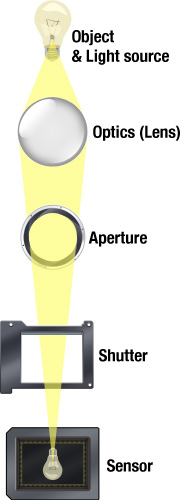Photography 101
#1
With all the photo taking in TS and different members asking about which camera, what lens and how did you do that... I thought a 101 course thread might help. I will start it off with a simple explanation of the 4 elements that control the quality of the image (not the composition) Shutter speed, Aperture, ISO, and actual lighting conditions.
The lighting conditions it the one thing that you cannot do anything about (for now ) you will need to understand the other three and adjust them to fit the conditions you want to work in...
) you will need to understand the other three and adjust them to fit the conditions you want to work in...
Here we go
From: Photography Basics | Tutorial9
The lighting conditions it the one thing that you cannot do anything about (for now
 ) you will need to understand the other three and adjust them to fit the conditions you want to work in...
) you will need to understand the other three and adjust them to fit the conditions you want to work in...Here we go
The illustration shows the path the light travels from the object to the sensor (or film in non-digital cameras).

First the light needs to go through the lens, which is a series of differently shaped pieces of glass. If the focus is good then the light will meet on the sensor.
The aperture is placed inside the lens and is basically an opening that controls how much light reaches the sensor.
On most modern cameras the shutter is placed inside the camera body. This piece of mechanics is what controls how long time the sensor is exposed to the light.
The sensor is a very sensitive plate where the light is absorbed and transformed into pixels. As you can see on this illustration, the image the sensor picks up is actually upside down, just like our eyes sees the world, the processor inside the camera then flips it.
Aperture

The aperture sits inside the lens and controls how much light passes through the lens and onto the sensor. A large aperture lets through very much light and vice versa. Knowing how the aperture affects the photograph is one of the most important parts of photography — it affects the amount of light, depth of field, lens speed, sharpness and vignetting among other things. I will talk more about these things in later parts of this series.
F-numbers, a mathematical number that expresses the diameter of the aperture, are an important part of understanding how the aperture and exposure work. All f-numbers have a common notation, such as ƒ/5.6 for an f-number of 5.6. There are a set numbers of f-numbers that are used in photography, there are several different scales but the “standard” full-stop f-number scale is this:
ƒ/# 1.4 2 2.8 4 5.6 8 11 16 22 32
These are known as full-stop f-numbers. If you decrease the f-number with one full-stop, like ƒ/4 to ƒ/2.8, the amount of light that passes through will double. If you increase the f-number with one full-stop, like ƒ/5.6 to ƒ/8, only half the amount of light will reach the sensor.
There can be several f-numbers between the ones above — depending on what scale is being used. The most common one is a 1/3 scale, which means that every third step is a full-stop, and thus giving you two settings between every full-stop. For example between ƒ/8 and ƒ/11 you will find ƒ/9 and ƒ/10. This can be rather confusing at first, so here’s a short reminder:
A higher f-number = a smaller aperture = less light
Shutter

The shutter is what controls how long the sensor is exposed to the light. The longer the shutter is open the more light can be captured by the sensor. A fast shutter speed will result in “freezing” a moving object and a slow shutter speed will let you capture the motion of a moving object.
There is a scale of stops for the shutter speeds just like for the aperture, below are the full-stops.
1/1000 s 1/500 s 1/250 s 1/125 s 1/60 s 1/30 s 1/15 s 1/8 s 1/4 s 1/2 s 1 s
And just as with the aperture, the shutter speed is often on a 1/3 scale, giving your two steps in between every full-stop. For example between 1/60s and 1/125s you will find 1/80s and 1/100s.
ISO
The ISO speed (the name comes from the International Organization for Standardization) is a measure of the film speed, or its sensitivity to light. With digital cameras the ISO affects the sensor instead of the film, but the principal is the same. A low ISO speed requires a longer exposure and is referred to as slow, a high ISO speed requires less time to give the same exposure and is therefore referred to as fast. One step in the ISO equals one full-stop, so the ISO is not on a 1/3 scale — film can be found with 1/3 ISO speeds, but it’s uncommon in the digital world. These are the most common ISO speeds.
ISO 50 100 200 400 800 1600 3200
On 35mm film, a film with high ISO speed had much more grain than a slower film — but the modern sensors don’t create the same grain with high ISO speeds. Instead it creates noise. The digital noise is not as favorable as the film grain and can destroy a photo if it’s too visible (the same goes with the grain, but it’s effect was more subtle and often more liked).
If light is no problem, then always use a low ISO number but if you’re indoors with bad light or other conditions when you find the combination of aperture/shutter not to be enough the ISO speed can be a great asset. New digital sensors are constantly developed and the noise levels with high ISO speeds are decreasing with every new release.

First the light needs to go through the lens, which is a series of differently shaped pieces of glass. If the focus is good then the light will meet on the sensor.
The aperture is placed inside the lens and is basically an opening that controls how much light reaches the sensor.
On most modern cameras the shutter is placed inside the camera body. This piece of mechanics is what controls how long time the sensor is exposed to the light.
The sensor is a very sensitive plate where the light is absorbed and transformed into pixels. As you can see on this illustration, the image the sensor picks up is actually upside down, just like our eyes sees the world, the processor inside the camera then flips it.
Aperture

The aperture sits inside the lens and controls how much light passes through the lens and onto the sensor. A large aperture lets through very much light and vice versa. Knowing how the aperture affects the photograph is one of the most important parts of photography — it affects the amount of light, depth of field, lens speed, sharpness and vignetting among other things. I will talk more about these things in later parts of this series.
F-numbers, a mathematical number that expresses the diameter of the aperture, are an important part of understanding how the aperture and exposure work. All f-numbers have a common notation, such as ƒ/5.6 for an f-number of 5.6. There are a set numbers of f-numbers that are used in photography, there are several different scales but the “standard” full-stop f-number scale is this:
ƒ/# 1.4 2 2.8 4 5.6 8 11 16 22 32
These are known as full-stop f-numbers. If you decrease the f-number with one full-stop, like ƒ/4 to ƒ/2.8, the amount of light that passes through will double. If you increase the f-number with one full-stop, like ƒ/5.6 to ƒ/8, only half the amount of light will reach the sensor.
There can be several f-numbers between the ones above — depending on what scale is being used. The most common one is a 1/3 scale, which means that every third step is a full-stop, and thus giving you two settings between every full-stop. For example between ƒ/8 and ƒ/11 you will find ƒ/9 and ƒ/10. This can be rather confusing at first, so here’s a short reminder:
A higher f-number = a smaller aperture = less light
Shutter

The shutter is what controls how long the sensor is exposed to the light. The longer the shutter is open the more light can be captured by the sensor. A fast shutter speed will result in “freezing” a moving object and a slow shutter speed will let you capture the motion of a moving object.
There is a scale of stops for the shutter speeds just like for the aperture, below are the full-stops.
1/1000 s 1/500 s 1/250 s 1/125 s 1/60 s 1/30 s 1/15 s 1/8 s 1/4 s 1/2 s 1 s
And just as with the aperture, the shutter speed is often on a 1/3 scale, giving your two steps in between every full-stop. For example between 1/60s and 1/125s you will find 1/80s and 1/100s.
ISO
The ISO speed (the name comes from the International Organization for Standardization) is a measure of the film speed, or its sensitivity to light. With digital cameras the ISO affects the sensor instead of the film, but the principal is the same. A low ISO speed requires a longer exposure and is referred to as slow, a high ISO speed requires less time to give the same exposure and is therefore referred to as fast. One step in the ISO equals one full-stop, so the ISO is not on a 1/3 scale — film can be found with 1/3 ISO speeds, but it’s uncommon in the digital world. These are the most common ISO speeds.
ISO 50 100 200 400 800 1600 3200
On 35mm film, a film with high ISO speed had much more grain than a slower film — but the modern sensors don’t create the same grain with high ISO speeds. Instead it creates noise. The digital noise is not as favorable as the film grain and can destroy a photo if it’s too visible (the same goes with the grain, but it’s effect was more subtle and often more liked).
If light is no problem, then always use a low ISO number but if you’re indoors with bad light or other conditions when you find the combination of aperture/shutter not to be enough the ISO speed can be a great asset. New digital sensors are constantly developed and the noise levels with high ISO speeds are decreasing with every new release.
Last edited by GrayTT; 08-26-2011 at 08:23 AM.
#5
Here are a few pix to illustrate the relationship of aperture to the depth of field (DOF)...
Depth of field is the distance between the nearest and farthest objects in a scene that appear acceptably sharp in an image
Lighting inside the room was terrible but I still went with an ISO to 200. I had the camera set the shutter speed for me as I went through different f-stops to play with the DOF...
My focus point was the number 3

f 1.4
Notice how tight the DOF is, it is very much my focus plane... in other works as soon as you start looking at things in front or just behind the plane that the number 3 is in, you will notice its not sharp (look at the edge or ball 2 and ball 4).

f 3.2
Here you can see that the POF is widening, both ball 2 and 4 and sharper now

f5.0
POF is even wider/deeper

f10
Here all five balls are pretty sharp but not the 8 ball in the back

f16
Here you can see great depth but the shutter speed was 2.0 seconds due to the small aperture... so you will need to set the camera on something
Depth of field is the distance between the nearest and farthest objects in a scene that appear acceptably sharp in an image
Lighting inside the room was terrible but I still went with an ISO to 200. I had the camera set the shutter speed for me as I went through different f-stops to play with the DOF...
My focus point was the number 3

f 1.4
Notice how tight the DOF is, it is very much my focus plane... in other works as soon as you start looking at things in front or just behind the plane that the number 3 is in, you will notice its not sharp (look at the edge or ball 2 and ball 4).

f 3.2
Here you can see that the POF is widening, both ball 2 and 4 and sharper now

f5.0
POF is even wider/deeper

f10
Here all five balls are pretty sharp but not the 8 ball in the back

f16
Here you can see great depth but the shutter speed was 2.0 seconds due to the small aperture... so you will need to set the camera on something
#7
I don't think its meant to be an acronym for International Organisation for Standardisation but its the "Film Speed" standard set but the organization back in the mid 70s.
#9
Great tutorial, Hani! I'll post up some tutorials on panning (great for shooting race cars and such) when I get a chance later this week. I've got 4 shoots I need to finished editing before I'll have time to really go in depth though.





 you mean the on and off button???
you mean the on and off button???
